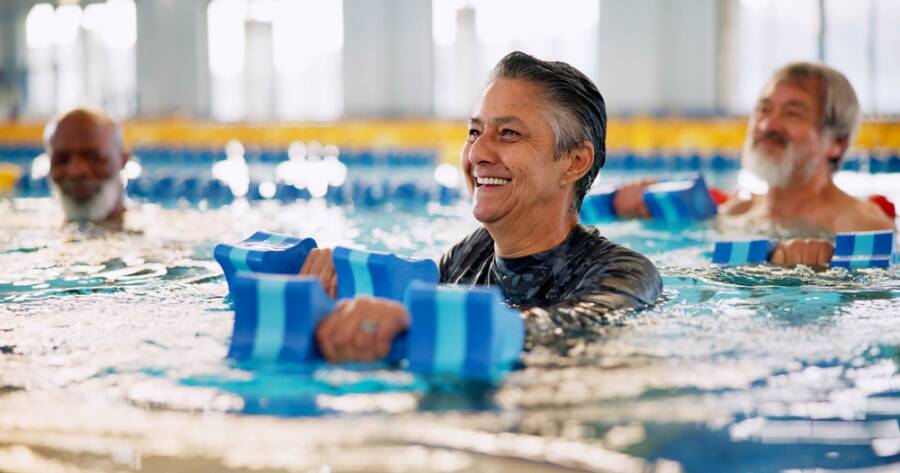You don’t have to jump, sprint, or lift heavy to get an effective workout. Low-impact exercises can be incredibly powerful–building strength, improving mobility, and supporting heart health–all while being gentle on your joints. Whether you’re recovering from injury, managing arthritis, or simply want a more sustainable way to move, low-impact workouts offer a smart solution. With the right moves, you can stay active, strong, and pain-free without pushing your body past its limits.
Walking
Walking is one of the easiest and most underrated low-impact exercises. It strengthens your legs, improves cardiovascular health, and supports weight management, all without putting pressure on your joints. Whether you’re moving through your neighborhood, a local trail, or on a treadmill, walking is accessible to almost everyone and easy to incorporate into your daily routine.
You can make walks more effective by varying your pace, adding light hand weights, or choosing routes with gentle inclines. Even a brisk 20–30-minute walk a few times a week can boost endurance and lift your mood. Best of all, walking is low risk and requires no special equipment, ust supportive shoes and the willingness to move.
Swimming
Swimming is one of the most joint-friendly exercises you can do. Because water supports your body weight, it reduces stress on your joints while still offering resistance that strengthens your muscles. It works nearly every part of the body (arms, legs, core, and back) while also giving your heart a great workout.
Whether you’re swimming laps, doing water aerobics, or simply moving in the shallow end, the water provides a soothing environment for people with arthritis, injuries, or mobility challenges. It’s also a fantastic way to improve flexibility and coordination without the wear and tear of high-impact workouts. For both beginners and seasoned exercisers, swimming delivers big benefits with a low risk of injury.
Cycling
Cycling (whether on a stationary bike or outdoors) is a great way to get your heart pumping without stressing your knees or hips. The circular motion of pedaling is gentle on joints while strengthening the legs, especially the quads and hamstrings. It also improves endurance and helps burn calories.
If balance is a concern, recumbent bikes offer additional support and stability. You can adjust the resistance to fit your fitness level, making it easy to progress gradually. Cycling is especially helpful for people recovering from knee injuries or looking to build strength without running or jumping. Just a few sessions a week can increase cardiovascular health and support long-term joint mobility.
Pilates
Pilates focuses on slow, controlled movements that strengthen the core, improve posture, and enhance flexibility, all while being incredibly gentle on the joints. Many Pilates exercises are done lying down or seated, which minimizes pressure on the knees, hips, and ankles. It’s an ideal low-impact option for improving overall body awareness and alignment.
Pilates also promotes better joint stability by targeting the smaller muscles that support your movement patterns. Whether you’re using a mat or working with a reformer machine, Pilates can be tailored to your level and physical needs. Over time, it can help reduce aches and pains by correcting imbalances and building strength in a thoughtful, joint-safe way.
Yoga
Yoga blends movement, breath, and mindfulness into a low-impact workout that enhances flexibility, balance, and mental clarity. Many yoga styles, such as Hatha or restorative yoga, are especially gentle and suitable for people with joint concerns. Poses can be modified using props like blocks and straps to reduce strain and support the body.
Yoga helps lengthen tight muscles, increase range of motion, and improve circulation, all of which support joint health. Plus, its focus on controlled breathing and relaxation helps lower stress, which may reduce inflammation over time. Practicing yoga just a few times a week can increase mobility and provide a strong foundation for a healthy, balanced body.
Strength Training with Resistance Bands or Bodyweight
Strength training doesn’t have to involve heavy lifting or high-impact movements. Using resistance bands or bodyweight exercises like wall sits, glute bridges, or modified push-ups can safely build strength while protecting your joints. Strengthening the muscles around your joints offers long-term protection by improving stability and reducing injury risk.
Resistance bands are especially helpful because they provide constant tension without the jarring impact of weights. They’re also lightweight, portable, and easy to use at home. Building muscle helps support everyday movement, improves bone density, and keeps your metabolism strong, all without the stress that traditional lifting might put on sensitive joints.
Move in a Way That Supports You
Low-impact workouts prove that you don’t need to push your body to the limit to feel strong, capable, and energized. Whether you prefer swimming, yoga, walking, or a mix of gentle movement styles, the key is finding exercises that feel good and support your long-term health.
When your workout routine respects your body’s needs, you’re more likely to stay consistent, and consistency is what brings results. Keep moving in ways that nourish, not punish, and your body will thank you for it.

